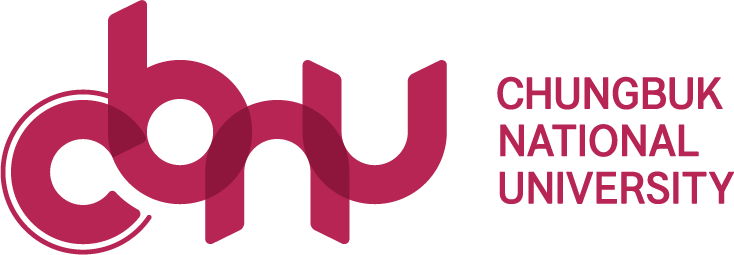International Affairs
| ■ KEY FACTS ABOUT COVID-19 BY KOR GOV(https://ncov.kdca.go.kr/en) | 작성일 | 2021.02.26 | 조회수 | 1,138 |
|---|
Korean government’s response system
* For updated news: https://ncov.kdca.go.kr/en
Since raising the country’s Crisis Alert Level to the highest (Level 4) in February 23, 2020, the Korean government has assembled the Central Disaster and Safety Countermeasure Headquarters headed by the Prime Minister to bolster government-wide responses to COVID-19.
Given the specialty and expertise required in infectious disease response, the Central Disease Control Headquarters (KCDC, Korea Centers for Disease Control & Prevention) serves as the command center of the prevention and control efforts. The Vice Head 1 of the Central Disaster and Safety Countermeasure Headquarters, who also serves as the Head of the Central Disaster Management Headquarters (Minister of Health and Welfare), assists the Central Disease Control Headquarters (Head: Director of the Korea Centers for Disease Control and Prevention).
The Minister of Interior and Safety, head of the Pan-government Countermeasures Support Headquarters, assumes Vice Head 2 of the Central Disaster and Safety Countermeasure Headquarters to provide necessary assistance such as coordination between the central and local governments.
Each local government establishes Local Disaster and Safety Management Headquarters led by the heads of the local governments to secure an adequate number of Infectious Disease Hospitals and beds. If the countermeasure required is beyond the capacity of local governments, the central government may support necessary resources including beds, personnel, and supplies.

Preventing the inflow and spread of the virus
Preventing importation of the virus through border screening
Special Entry Procedure (as of March 19, 2020)
The Korean government introduced an entry ban on foreign nationals from Hubei Province, strengthened visa screening of travelers from China and Japan, and designated China (including Hong Kong, Macau), Italy, and Iran as ‘quarantine inspection required areas’, to tighten screening of travelers from these countries.
In particular, from February 4, 2020, the Korean government applied the Special Entry Procedure to all travelers from China, and expanded the procedure to be applied to travelers from Hong Kong and Macau (February 12), Japan (March 9), Italy and Iran (March 12), five major European countries (France, Germany, Spain, U.K., and Netherlands; March 15), the entire European continent (March 16), and all parts of the world (March 19).
Furthermore, from March 19, all inbound travelers (Korean and foreign nationals) receive temperature screening and fill out the Health Questionnaire and Special Quarantine Declaration in accordance with the Special Entry Procedure. All travelers subject to the special procedure are allowed to enter the nation after their contact information and address of residence in Korea is verified. They are also required to install either the “Self-Quarantine Safety Protection App” or “Self-Diagnosis App” on their phones to monitor if they show symptoms that indicate infection of COVID-19 such as fever during their stay in Korea. All inbound travelers must install either of the two applications, to check their health status and record if they develop any symptom on a daily basis for 15 days beginning from the day of arrival. In addition, the list of incoming travelers is provided to each local government (city or province) in an effort to strengthen the monitoring system.
※ Self-health check symptoms: fever (37.5 or higher) or feverish feeling, cough, sore throat, respiratory difficulties or breathlessness
Stronger measures for infection prevention and control of overseas entrants
In light of the increasing number of confirmed cases especially among inbound travelers, from 00:00, April 1 all travelers entering Korea are subject to a 14-day quarantine from the day after arrival.
※ For example, if you arrived on 1 June you are required to stay under mandatory quarantine until 12:00 of 15 June.
In addition, from 00:00 on April 13, inbound travelers from the U.S. (Korean nationals and foreign-nationals on long-term visas) are subject to self-quarantine and must receive diagnostic tests within three days of their quarantine period.
Symptomatic travelers
All travelers entering Korea (both Korean and foreign nationals) are tested if they exhibit fever or respiratory symptom identified at entry screening. Travelers who test positive for COVID-19 are transferred to a hospital or residential treatment center. Korean nationals or foreign nationals on long-term visas who test negative are placed under self-quarantine (14 days, Self-Quarantine Safety Protection App to be installed) and foreign nationals on short-term visas are placed under quarantine at facilities (14 days, Self-Diagnosis App to be installed).
Asymptomatic travelers
Asymptomatic Korean and foreign nationals from Europe and the U.S. on long-term visas are subject to self-quarantine (14 days, Self-Quarantine Safety Protection App to be installed) and tested at a public health center within three days of arrival. Asymptomatic Korean nationals and foreign nationals on long-term visas from countries other than the U.S. and European countries are subject to self-quarantine (14 days, Self-Quarantine Safety Protection App to be installed) and tested at a public health center within 14 days.
Asymptomatic foreign nationals from Europe and the US on short-term visas are subject to facility quarantine (14 days, Self-Quarantine Safety Protection App and Self-Diagnosis App to be installed). Asymptomatic foreign nationals from countries other than the US and European countries on short-term visas are subject to facility quarantine (14 days, Self-Diagnosis App to be installed) and tested at a public health clinic within 14 days.
Travelers exempt from quarantine—those holding A1 (Diplomat) or A2 (Government official) visas or Quarantine Exemption Certificate issued by the Korean Embassy or Consulate General prior to the entry—receive tests and wait for the results at a temporary screening facility. If they test negative, they are subject to active monitoring for 14 days from the day of arrival by installing the Self-Diagnosis App of the Ministry of Health and Welfare
For inbound travelers, testing and treatment expenses are covered by the Korean government but livelihood support are not provided.
If a traveler entering Korea does not comply with the quarantine guidelines, s/he may face up to 1 year of imprisonment or a KRW 10 million fine for violating the Quarantine Act and Infectious Disease Control and Prevention Act. In accordance with the Immigration Act, foreign nationals violating the regulations may face deportation or ban on entry into Korea, etc.
※ Travelers will receive assistance to install either the Self-Quarantine Safety Protection App or Self-Diagnosis App before departure or while waiting for Special Entry Procedures.
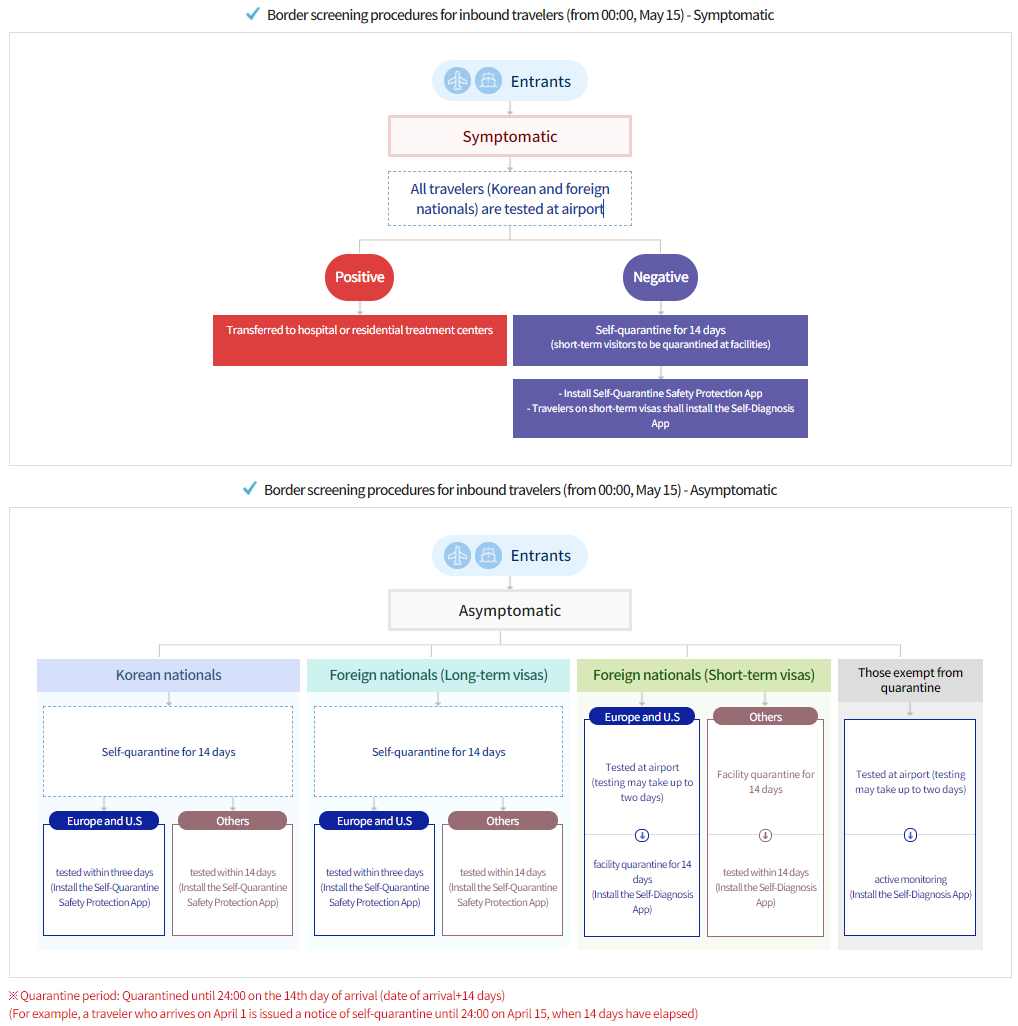
Providing medical institutions with access to overseas travel histories
The Korean government allows medical institutions to access overseas travel history of patients through the system that checks health insurance eligibility of patients, International Traveler Information System (ITS), and Drug Utilization Review (DUR).
Early detection and containment
Early detection is key to preventing the virus from spreading. The Korean government has set up screening stations to increase access to diagnostic tests and conduct fast and wide testing to detect confirmed cases.
COVID-19 screening stations
Screening stations provide consultation to people showing symptoms of COVID-19 such as cough or fever before they visit medical facilities. As of April 8, 2020, 638 public health centers and medical institutions operate screening stations, of which 95 percent (606) are equipped to collect specimens onsite.
Diverse forms of screening stations have been introduced such as drive-thru and walk-thru screening station.
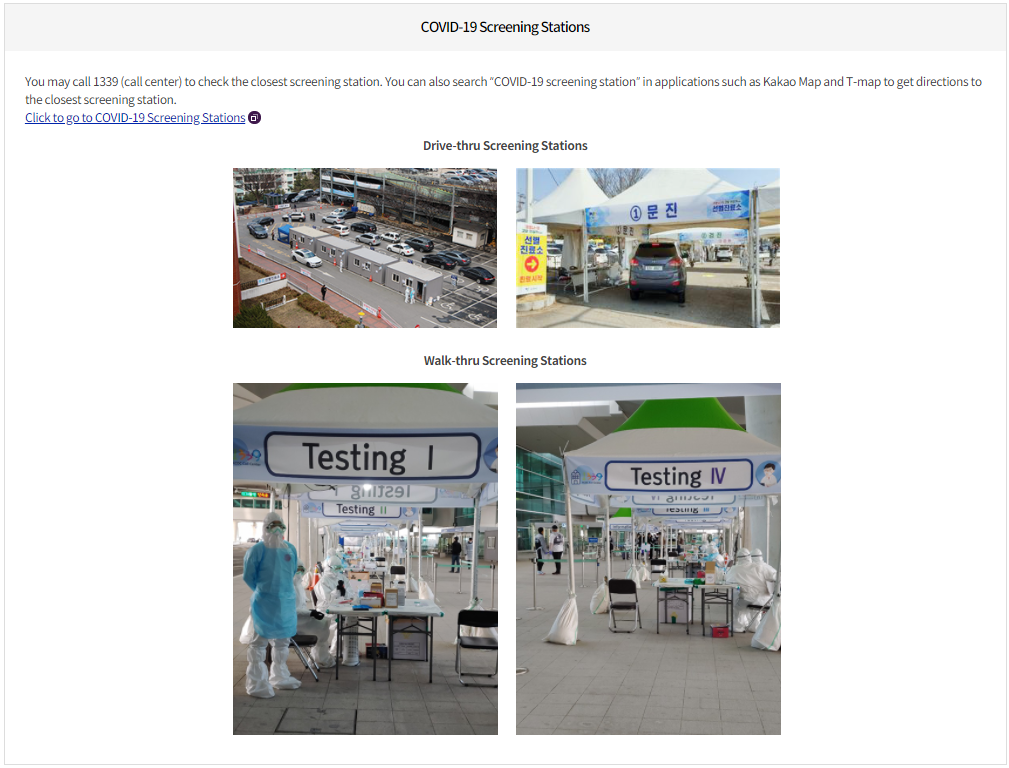
Diagnostic tests
There are currently 118 testing facilities—23 public facilities, 81 medical institutions, and 14 entrusted facilities—that provide diagnostic tests. As of April, a total of five diagnostic reagents were granted Emergency Use Authorization.
Since scaling up testing facilities and diagnostic reagents, the maximum daily testing capacity increased from 3,000 people in February to approximately 20,000 people as of April.
Preventing spread of the virus through epidemiological investigations and quarantine of contacts
Epidemiological investigation
The central and local governments respond to COVID-19 cases by tracing the source of infection through prompt epidemiological investigation and quarantine of contacts.
For epidemiological investigation, basic information including whereabouts of confirmed cases are collected through an interview with confirmed cases. If needed, interview with healthcare workers and family members may additionally take place. In case the acquired information is insufficient, more objective data (medical records, mobile GPS, CCTV footages, credit card records, etc.) may be collected and verified.
The contacts identified during the investigation are required to attend healthcare education, have their symptoms monitored, and stay in self-quarantine. Information on the whereabouts of confirmed cases are uploaded on websites in order to prevent any additional infection.
Contact management
Family members, housemates, and other contacts identified by epidemiological investigation on the patient’s travel and infection routes are subject to self-quarantine for the maximum incubation period (14 days) beginning from the day after the date of contact with a confirmed patient and have their symptoms monitored.
※ For example, a person who last came into contact with a confirmed patient on April 1 start self-quarantine until 24:00 on April 15, as April 2 is deemed the first day of the 14-day self-quarantine period.
The Ministry of Interior and Safety and local governments thoroughly manage those under self-quarantine on a one-to-one basis. Those in self-quarantine are prohibited from leaving the country for 14 days regardless of their health status. Those who violate self-quarantine guidelines may face up to a 10 million KRW fine or one year of imprisonment.
한국 정부 대응체계 (2020년 2월 25일 기준)
* 관련 홈페이지: http://ncov.mohw.go.kr/baroView2.do?brdId=4&brdGubun=42
한국정부는 감염병 위기단계를 「심각」수준으로 상향(‘20.2.23)함에 따라, 코로나19 대응을 위한 조직도 국무총리를 본부장으로 하는 중앙재난안전대책본부를 가동하여 범정부적으로 방역에 집중하고 있습니다.
감염병 대응의 특수성과 전문성을 고려하여 방역 컨트롤타워인 ‘중앙방역대책본부’(질병관리본부)가 수행하며, 중앙재난안전대책본부 1차장 겸 중앙사고수습본부장(보건복지부 장관)은 중앙방역대책본부(본부장: 질병관리본부장)의 방역업무를 지원합니다.
2차장은 범정부대책지원본부장인 행정안전부장관이 맡아 중앙 및 지방자치단체 간 협조 등 필요한 사항을 지원합니다.
각 지방자치단체에서도 단체장을 중심으로 ‘지역재난안전대책본부’를 구성하여 감염병전담병원과 병상을 확보하고, 수용범위를 넘어서면 중앙에서 병상, 인력, 물자 등의 자원을 지원합니다.

유입 및 확산 차단
입국 관리를 통한 감염병 유입 차단
특별입국절차
대한민국 정부는 후베이성에서 입국한 외국인의 입국을 금지하고, 중국 및 일본발 입국자 사증심사를 강화하였으며, 중국(홍콩, 마카오 포함), 이탈리아, 이란을 검역관리지역으로 지정하여 입국자 검역을 강화하고 있습니다.
특히, 대한민국 정부는 2020년 2월 4일부터 중국으로부터 한국으로 입국하는 모든 승객에 대해 ‘특별입국절차’를 시행하고 있으며, 홍콩‧마카오(2월12일), 일본(3월9일), 이탈리아‧이란(3월12일), 유럽 주요 5개국(프랑스 · 독일 · 스페인 · 영국 · 네덜란드, 3월 15일), 유럽 전역(3월 16일), 전세계 모든 입국자(3월 19일)로 적용지역을 확대하였습니다.
3월 19일부터 국내로 입국하는 모든 내 · 외국인은 특별입국절차에 따라 체온을 측정하고, 특별검역신고서와 건강상태질문서를 작성하여야 합니다. 특별입국대상자는 한국 내 연락처 및 거주지가 확인되어야 입국이 가능하며, 체류중 발열 등 감염가능성 확인을 위해 ‘자가격리자 안전보호 앱‘ 또는 ’모바일 자가진단 앱’을 설치하여야 합니다. 모든 입국자는 대상자별로 해당 앱을 설치 후 입국 당일부터 14일 간 매일 1회 본인의 증상을 확인하여 증상 발현 여부를 ‘앱’에 입력하여야 합니다. 또한, 입국자 명단은 각 시 · 도에 제공되어 각 지자체에서 감시체계를 강화할 수 있도록 하였습니다.
※ 자가진단 항목 : 발열(37.5도 이상) 또는 발열감, 기침, 인후통/목아픔, 호흡곤란/숨가쁨
해외 입국자 방역관리 강화 방안
대한민국 정부는 코로나19 환자 급증 및 국내 입국자 중 확진자 발생이 증가함에 따라 4월 1일(수) 0시부터 전세계 모든 나라에서 입국하는 모든 입국자는 입국일 다음날부터 만 14일이 되는 날의 12:00까지 격리생활을 하셔야 합니다.
※ 예를 들어 6월 1일 입국하신분은 6월 15일 12:00까지 자가격리 기간입니다.
유증상자
해외발 입국자 중 검역단계에서 발열 또는 호흡기 증상이 있는 경우 내외국인에 관계없이 진단검사를 실시하고, 검사결과 양성 시 병원 또는 생활치료센터로 이송됩니다. 검사결과 음성 시 내국인 및 장기체류 외국인은 자가격리(14일, 자가격리자 안전보호앱 설치)를 하고, 단기체류 외국인은 시설격리(14일, 모바일 자가진단앱 설치)를 하게 됩니다.
무증상자
무증상 입국자 중 내국인 · 장기체류 외국인의 경우, 자가격리(14일, 자가격리자 안전보호앱 설치)를 하고 3일 이내 보건소에서 진단검사를 받아야 합니다.
무증상 입국자 중 단기체류 외국인의 경우, 시설격리(14일, 모바일 자가진단앱 설치)를 하고, 인천공항 입국자의 경우 09:00~19:00에는 개방형 선별진료소에서, 19:00~09:00에는 임시생활시설에서 검체채취하여 진단검사를 실시합니다.
단, 격리예외자(비자 타입이 A1(외교), A2(공무)의 경우 또는 입국 전 한국 대사관(또는 총영사관)에서 ‘격리면제서’ 사전발급 받은 자)의 경우 진단검사를 받고 임시검사시설에서 검사결과가 나올 때까지 대기 후, 결과 음성 시 보건복지부의 ‘모바일 자가진단’ 앱을 설치하여 입국 당일 포함 다음날부터 14일간 능동감시를 받게 됩니다.
해외입국자에 대한 검사비와 치료비는 대한민국 정부가 지원하며, 생활지원비는 지원되지 않습니다.
해외입국자가 격리 규정을 지키지 않는 경우에는 검역법, 감염병예방법 위반으로 1년 이하의 징역 또는 1,000만원 이하의 벌금이 부과될 수 있으며, 외국인은 출입국관리법에 따라 강제추방, 입국금지 등의 대상이 될 수 있습니다.
※ '자가격리자 안전보호앱' 및 '모바일 자가진단앱' 은 현지출발 전 또는 특별입국절차 대기시간 동안 설치할 수 있도록 현장 지원
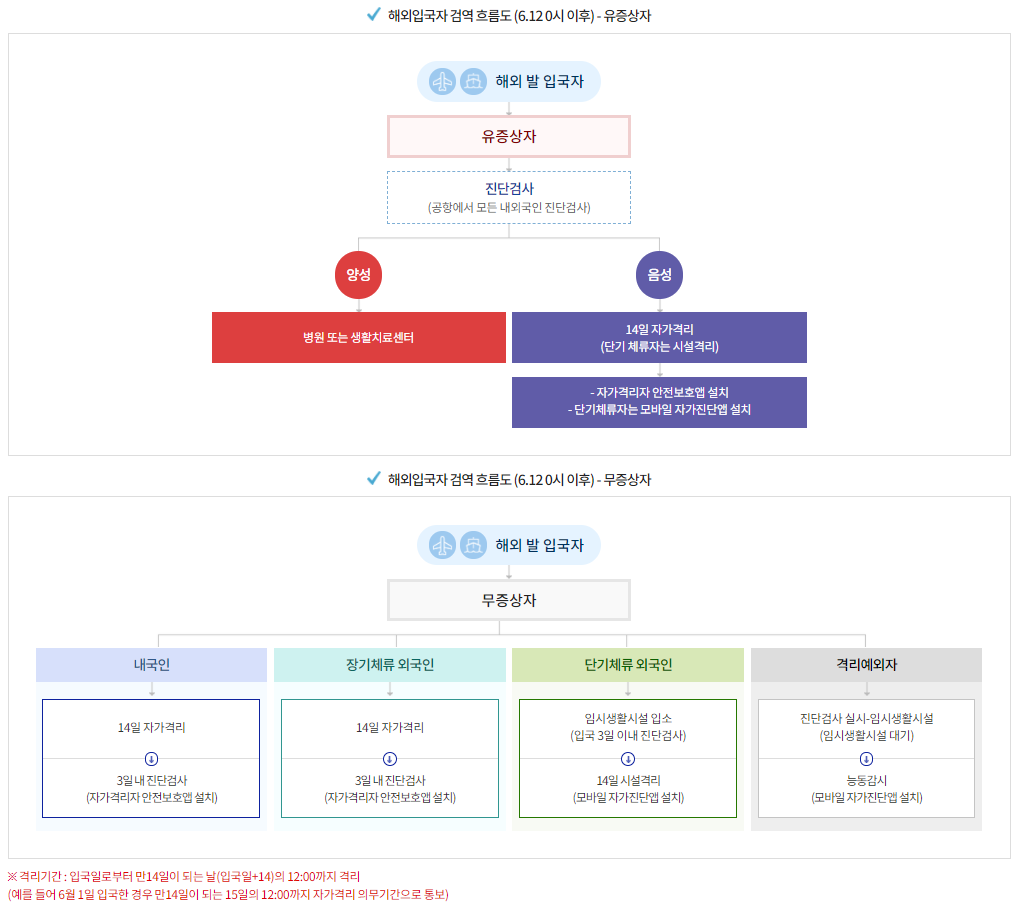
의료기관에 해외여행력 제공
대한민국 정부는 의료기관이 해외여행력을 확인할 수 있도록 수진자자격조회시스템(건강보험 자격확인), ITS(해외여행력 정보제공 프로그램, International Traveler Information System) 및 DUR(의약품안전사용서비스, Drug Utilization Review)를 통해 관련 정보를 제공하고 있습니다.
참조 - 한국발 입국자에 대한 조치 현황
코로나19 확산과 관련, 외국에서 우리나라 여행객에 대하여 취하고 있는 것으로 파악된 조치 사항을 안내하오니 해당국 방문 계획 마련 등에 참고하시기 바랍니다.
* 코로나19 확산 관련 한국발 입국자에 대한 조치 현황 [바로 가기]
감염 환자 조기발견을 통한 확산 차단
감염 확산을 사전에 방지하기 위해서는 환자를 조기에 발견하는 것이 필요합니다. 대한민국 정부는 선별진료소를 운영하여 환자들의 진단검사 접근성을 높이고, 대규모의 빠른 진단검사를 통해 환자를 찾아내고 있습니다.
선별진료소
선별진료소는 기침이나 발열 등 감염증 의심증상자가 의료기관 출입 전 별도로 진료를 받도록 하는 공간입니다. 20.4.8. 기준, 638개 보건소와 의료기관이 선별진료소를 설치하여 운영 중에 있으며, 이 중95%에 해당하는 606개소에서 직접 검체채취를 합니다.
최근에는 동차 이동형(Drive Thru), 도보 이동형(Walk Thru) 등 선별진료소 운영모델 또한 다양화하고 있습니다.
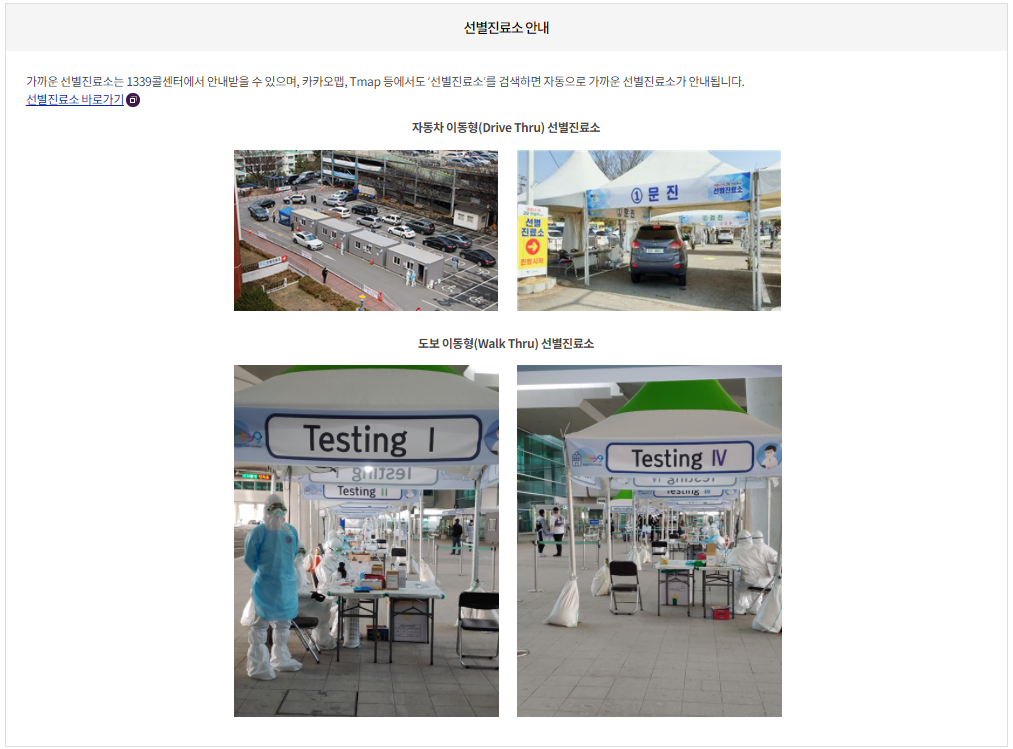
진단검사
진단검사를 실시하는 곳은 총 118개소로, 공공기관 23개, 의료기관 81개, 수탁검사기관 14개이고, 진단시약은 4월 현재까지 총 5개가 긴급사용승인 되었습니다.
그 간 검사기관 및 긴급사용 진단시약을 확대한 결과, 최대 하루 검사 가능역량이 2월 기준 3천명에서 4월 현재 약 2만명까지 확대되었습니다.
역학조사 및 접촉자 격리를 통한 확산 차단
역학조사
환자 발생 시 중앙 · 지자체는 신속한 역학조사를 통해 감염원을 추적하고 접촉자를 격리하고 있습니다.
역학조사 시 환자 인터뷰를 통해 동선 등 기본적인 정보를 파악하고, 의료진 및 가족 인터뷰가 추가적으로 이루어지기도 합니다. 조사 단계에서 파악된 정보의 보완이 필요하다고 판단되는 경우, 보다 객관적인 정보(의무기록, 핸드폰 위치정보, CCTV, 신용카드 기록 등)를 수집‧확인할 수 있습니다.
수집된 정보를 바탕으로 확인된 접촉자는 보건교육, 증상모니터링과 함께 자가격리 조치를 받게 되며, 추가 감염을 막기 위해 확진자의 동선은 홈페이지 등을 통해 공개하고 있습니다.
접촉자 관리
역학조사를 통해 환자의 동선과 감염경로를 중심으로 확인된 가족, 동거인 등 접촉자들은 확진환자 최종접촉일 다음날부터 최대 잠복기(14일) 동안 자가격리하며, 코로나 19 의심증상이 발생하는지에 대한 모니터링을 받게 됩니다.
※ 격리기간: 최종접촉일로부터 만14일 되는 날(최종접촉일+14)의 12:00까지 격리
* (예시) 최종접촉일 (4.1일)로부터 만 14일이 되는날인 4.15일 정오(12:00) 격리해제
**단, 시설격리일 경우 시설의 상황에 따라 격리해제 시각 변동 가능
자가격리자는 1:1 전담 관리를 통해 행정안전부와 지방자치단체가 철저하게 관리합니다. 자가격리자는 증상 여부와 관계없이 14일간 출국 금지되며, 자가격리 위반 시에는 1천 만원 이하 벌금이나 1년 이하 징역을 부과합니다.
